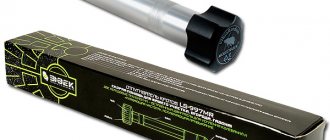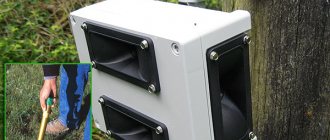The inhabitants of the “dungeon” loosen the soil and thereby contribute to its aeration. They also eat invertebrate garden pests. However, moles often damage the roots of vegetables, flowers and fruit trees. How to get rid of moles on the site?
As children, many of us were touched by the cheerful animal from the popular Czech cartoon directed by Zdenek Miler. But then we grew up, bought a summer cottage, and with it the “local residents” - moles. That's when the cute mole turned from a friendly animal into an annoying pest that destroys the lawn and spoils the beds.
Why is a mole dangerous on the site?
Although these animals are small and feed on insects, they are dangerous for the crops grown on the site. Moles dig tunnels at a shallow depth underground, in which the food they need accumulates - earthworms, wood lice, slugs, larvae, etc., even snakes and frogs. Underground animals do not compete with humans in the food chain; they do not feed on plant crops, however:
- by making tunnels, they mercilessly destroy the root systems of plants, causing significant damage to the future harvest;
- Through dug holes, earth mice and rats enter the area and feed on the grown crops.
Moles mercilessly destroy the root systems of plants.
You can understand that there are moles in the area by looking at the loose mounds of soil that the animals throw to the surface when creating burrows.
The way to deal with moles is to fill the holes with water.
Every 4 hours I turned on the pump and poured water into the holes from a hose. This continued for 3 days. I would have continued further, but after 3 days the first result of my efforts appeared.
The neighbors' outdoor toilet surfaced.
That same evening we learned that there was a second result of my efforts - the lower ring of the well was covered with sand. The well had to be cleaned, after cleaning we learned the third result.
The water level in the well was restored not 4 hours after downloading, as was before, but after 40 minutes. It turned out that we “rocked” the well. This is a positive result.
What about moles? They continued to frolic in the beds and eat worms!
Description and principle of operation of the mole net
Having tried many repellent methods such as strong-smelling drugs or broken glass around the perimeter, owners of country gardens organize reliable protection by installing special nets. The device is simple, but very effective; it does not require special knowledge during installation, but it lasts for years.
By burying the net in the ground, surrounding a garden or an entire plot, it is possible to create an impassable obstacle for the animal. There are two ways to place a barrier:
- Horizontally, along a grass lawn or flower bed. The method is suitable for cases when moles have already appeared on the site. Digging a passage from below to the surface and encountering a net, the animal is forced to go around the barrier in one direction or another, moving until it leaves the perimeter. As a result, it often leaves the site completely.
- Vertically, in the manner of a fence deeply sunk into the ground. If there are no animals on the site yet, a vertical barrier is built along the entire perimeter. As a result, they cannot penetrate from the outside.
A good protection for the area is a mole net.
The horizontal method has pros and cons. Among the advantages:
- the mesh additionally protects against soil erosion and does not allow precipitation to wash away fertile soil;
- slopes on loose soils are strengthened;
- the underground hard layer protects the roots of grass crops from trampling.
However, only a lawn or flower garden can be protected in this way, since the material has to be laid to a shallow depth. The method is not suitable for ordinary vegetable gardens - digging up the soil will become impossible. True, if you build high greenhouse beds, horizontal laying of mesh can be used quite successfully.
Traps
Setting traps is the most effective and practical method of limiting the number of moles. In general, traps are most effective in the spring and fall, especially after rain. In summer or winter, moles are deep in the soil and it is difficult to determine their location. Of all the traps, the most effective are the following three types: harpoon, scissor-jaw, and choker loop. The trap should be installed in the active plane of the hole (i.e., where the mole is coming from) strictly according to the instructions.
Tunnel traps, similar to those shown in the photo below, are installed in pairs, in opposite directions (see photo_7), because it is unknown which direction the mole will come from. I usually use passages under the path tiles to set traps. To prevent the mole from moving the traps, I secure them with a stick stuck into the ground, threading it through the hole in the spring part of the trap.
The photo shows a regular spring mole trap that you can buy in a store.
sunnygarden.ru
Choosing the right material
There are polymer (plastic) and metal mesh coatings on the market. You need to choose a material with a small cell size, through which the mole cannot crawl, but at the same time, the holes should not be too small to allow the roots of the planted crops to pass through.
Metal meshes are durable, but they quickly oxidize in the ground, becoming unusable. As a result, sooner or later the mole will dig through it.
Polymer varieties are more practical - they are not afraid of dampness, so their service life is unlimited. Two types of polymer are used:
- Polyethylene. It is environmentally friendly, does not decompose in the ground, but has low strength. A mole will not be able to tear it, but field mice or rats will easily gnaw through it.
- Polypropylene. The technical characteristics are the same, but the strength is noticeably higher.
Plastic lawn mesh against moles
Experienced gardeners who have tried different coating options recommend choosing products made of thick polypropylene with cell sizes of 1.5–2.5 cm (dimensions of animals: up to 13 cm in length and 5–8 cm in width). Such material does not rot and is not torn by moles. By covering all the “high” beds in greenhouses with similar nets (horizontally), it is possible to completely get rid of annoying underground guests.
When choosing a mesh in a store, try to tear the material from the edge with your hands, using all your strength. If the product breaks without problems, the animal can handle it too. Often it is cheap materials that are stronger.
Author's advice
Protecting a frame house from rodents
Protection against mice in a frame house will make all attempts by rodents to enter your home useless
It is extremely important to think through protection methods at the stage of developing a house project. There are several effective ways; controlling rodents in a frame house will not be difficult for you:
- Choose mineral wool as insulation; the material not only saves wood, but also prevents rodents from settling in the frame;
- Treatment of building materials with special solutions that repel pests;
- The use of traditional methods: treating internal walls with ash or tobacco dust, adding sprigs of peppermint or wormwood, the smell of which repels rodents;
- A special metal mouse mesh is used in the frame house, which acts as a reliable barrier between the environment and your home.
Applying a grid
Metal mesh against rodents is installed in a frame house, both at the construction stage and after the construction of the frame structure. The material is quite easy to use and allows you to protect the frame from small and large pests (mice, moles, rats).
Rodent mesh in frame.
The mesh is absolutely safe for the environment, at the same time it copes with high and low temperatures and is inexpensive. Remember that the anti-rodent mesh must have small cells, and the wire thickness must be at least 2 mm. Otherwise, pests will easily bite through the mesh and still get into the home.
Floor protection
Note: Protecting a frame house from rodents begins with the floor, since this is the most possible place for pests to enter. When arranging the floor, you can use either a metal mesh or a monolithic reinforced concrete slab.
An equally effective way to protect the floor is to use expanded clay. The material, which is baked clay, is poured when arranging the subfloor, a layer of at least 300 mm. An ordinary polyethylene film is laid on top of the material, then two OSB boards are laid, the final stage is another layer of expanded clay. By making a subfloor using this method, you can protect your home from pests.
In some cases, particle boards impregnated with boric acid and wax are also added to the “sandwich” of the subfloor. The substances actively repel rodents.
Wall protection
Often future owners of a frame house are interested in what material is best to use for cladding a frame house to prevent rodents from chewing through the wall and entering the house.
To prevent mice from infesting the walls of a frame house, you can use special profiled metal sheets made of steel. The thickness of such a sheet is more than 1.5 mm. This coating is too slippery for mice, which prevents them from entering the room. Another effective option is to use a metal mesh.
Step-by-step instructions for installing the mesh
Each method involves its own technology for laying the mesh covering. There are also some subtleties, knowledge of which will help create a real barrier.
Horizontal method
Let us repeat that this method is used exclusively for arranging a lawn or raised beds in a greenhouse, since the depth of the protective material is shallow. Laying is carried out as follows:
- The top fertile layer of soil is removed to the required depth (about 15–20 cm for a flower garden or bed, 5–10 cm is enough for a rolled lawn). The turf can simply be cut and laid in the shade, covered with a damp cloth.
- If necessary, the area is leveled.
- The mesh is laid, the edges are pressed to the ground with staples. The mesh should extend beyond the area of the flower bed or lawn on all four sides, otherwise the mole will easily dig a tunnel over the protective structure. At the joints, the sheets are laid with a 10-centimeter overlap, and they are also fastened with staples, without leaving even the slightest loophole for the mole.
- A removed layer of fertile soil is poured on top, which is immediately loosened, leveled and watered. Leave to soak for 2 days.
- A rolled lawn is laid on top or lawn grass seeds are sown in the soil.
- The surface is mulched and watered abundantly.
The horizontal method involves preliminary leveling of the surface.
A horizontally laid mesh will also protect the soil from sliding if there is a slope.
Even when laying a lawn roll, it is better to deepen the mesh into the soil rather than attach it near the surface. Moles will still dig right under the lawn; characteristic swellings will appear on the surface, into which you can accidentally fall while walking.
Vertical method
The method is more complicated, but allows you to protect an area untouched by animals from possible invasion. Installation of the anti-mole net is carried out according to the following principle:
- A trench 80 cm deep is dug along the perimeter of the site (the animal’s living hole is located at a depth of 1.5–2 m, but feeding passages stretch near the surface at a depth of 5–50 cm). A trench width of 30 cm is sufficient for subsequent laying of material. They dig only from unprotected sides; the presence of a deep strip foundation under the fence or proximity to the road makes the task easier.
- The net is installed in a trench so that the edge protrudes 20 cm above the surface. Adults practically do not come up, but mature young animals are able to move along the surface in search of a new place of settlement.
- In dense soil, a vertically installed mesh is fixed with staples; in loose soil, it is secured with a stapler to wooden blocks. When connecting two rolls, an overlap of 10 cm is required.
- They dig a trench, simultaneously compacting the earth.
- It is advisable to connect the edges of the material protruding at the top with a fence or garden border.
Scheme of horizontal and vertical installations
Solid option
In this case, you have to combine both previously described methods. One edge of the mesh is dug vertically to a depth of 80 cm at the border of the site, then the material is pulled over the top, deepening horizontally to a depth of 10 cm in places where lawns or beds are expected.
In this way, it is possible to close the entire area from uninvited guests - both from all sides and from below.
Repellents
If the land plot is not yet surrounded by an anti-mole barrier, the animals can be scared away from it. In the old days, they used hollow reed stems, which were inserted deeply into the earthen passage. There was 40-50 cm of tube left on top. The wind hitting it made an unpleasant sound, and the pests left.
Sound repellers
Using the sensitivity of moles to certain sound vibrations, today's gardeners are actively using special gadgets - both electronic and homemade:
- Infrasound devices Produce low-frequency sound that is not detected by the ear, but causes vibration of the ground on the land. Moles, which have a developed sense of touch, perceive this vibration as a signal of danger and leave. The devices are effective, but can cause headaches in sensitive people. An example of a fairly effective and inexpensive infrasound “Anti-Crote” is shown in the photo:
- Sound repellers Generate sounds of various frequencies within the audible range. They create a constant noise effect in underground labyrinths, forcing moles to look for a quieter place. Can create additional soil vibration. They are safe for people, but have a small radius of action - 800-1500 m2, so they are suitable for repelling only small garden areas.
- Homemade ratchets An example would be an empty tin of beer, in which slits are made, bent with “petals”, the entire structure is put on a pin and inserted into the molehill. The wind makes the jar spin and ring, scaring away the moles. Such ratchets only operate at the installation site, are highly dependent on the weather and are useless on windless days.
In terms of efficiency and aesthetics, industrial devices, of course, are superior to homemade ones. The main thing is to purchase them from a trusted manufacturer.
It is also important to avoid sellers offering ultrasonic repellers. Moles, like people, do not perceive the ultrasonic range and do not react to it in any way.
Chemical repellers
The action of these products is aimed at the sensitive sense of smell of moles. The animals do not tolerate strong odors well, which prevent them from hunting, and go to another place. The following chemical repellers have proven themselves to be effective:
- Alphos Mole+ is available in the form of tablets that are placed in molehills. They release aluminum phosphide, which is considered an insecticide, but also irritates the moles' sense of smell. At high concentrations, this gas can kill animals.
- PhostoxinTableted drug is an analogue of the previous one. The active ingredient is aluminum phosphide, the principle of action is exactly the same.
- DetiaBiological product in the form of balls soaked in plant essential oils. The manufacturer recommends not throwing them into molehills, but digging them in throughout the entire area to a depth of 20 cm.
- Dr. Klaus A preparation in the form of a liquid concentrate based on citronella and castor bean oils. The bottle is equipped with an ejector, which is connected to the irrigation hose. The drug, when mixed with water, enters the soil and has a repellent effect. Treatments are repeated throughout the season, every 2-3 weeks.
Experience shows that not all products with a strong odor work equally well. For example, there are many negative reviews of the garlic-based drug “Krotomet”.
Folk remedies
Popular “bookmarks” for repelling moles work in a similar way:
- wicks soaked in turpentine, kerosene, ammonia;
- mothballs or camphor balls, poured into the passages;
- rotten eggs and fish.
The disadvantage of these tools is that you need to spend a lot of time expelling moles with their help, constantly updating the “bookmarks”. During this time, the animals are able to cover up a foul-smelling hole and dig a new one.
“Smoking” animals with calcium carbide and smoke bombs does not have this disadvantage. A small amount of carbide is placed in the molehill and filled with water. The checkers are set on fire, inserted into the moves and covered with an inverted bucket. The gases released during this process spread throughout the labyrinth and force the pest to leave its habitable place.
The most effective products
We will recommend to readers some brands of anti-mole nets that are popular among amateur gardeners and landscape designers
Protect G8
The diameter of the cells is small (8x6 mm), which will also protect against small voles. The polymer material is reinforced and can withstand the pressure of sliding soil up to 20 tons per meter. Does not rust, does not rot. Service life is about 25 years. Roll weight: 10 kg.
Protect G9
The mesh is made of polymer reinforced material. The cell diameter is 9x9 mm. The product also holds a load of up to 20 tons per 1 m and is not afraid of corrosion or rotting. The service life of Protect G8 is up to 25 years, roll weight: 10 kg.
Syntoflex
Manufacturer: Italian company Tenax. This is a premium product: the mesh is thinner than competitors, but stronger and more flexible. The cell dimensions are 12x14 mm. Service life – up to 25 years.
Lawn mesh Grinda
A product of a Lithuanian company that produces equipment and materials for gardeners and gardeners. Anti-mole nets are made of polyethylene, painted black. The cell size is 9x9 mm, the roll width is 1 m, the length is 10 m.
Mole net CP15
Polypropylene material from a Russian manufacturer. The cells have a size of 13 by 15 mm, the width of the roll is 1 m, the length is 20 m. It is available in green and blue colors, which allows the mesh to be used as a decorative fence.
Grinda
Russian SR15
Syntoflex
Protect G8
Types of ready-made traps
There are quite a few ready-made mole traps, for example: scissor traps, tunnel traps, plunger traps, pipe mole traps (also called humane traps) or live traps, ultrasonic repellers. Let's look at each trap in detail.
Scissor trap
There are many options for such devices, which are most often found in gardening stores, etc.
The photo shows a simple example of a scissor trap
Advantages:
- Easy to install (just press the handles into the ground and cock the mechanism).
- You can observe the operation from a distance.
- It is easy to adjust the sensitivity of the device.
- Simple but reliable design.
Flaws:
- Although easy to use, the trap is difficult to install in a tunnel opening, especially at great depths. It must be located and hidden so that the moving parts are not obstructed in the form of stones, pieces of peat, or clods of earth. Due to the tight handles, it is difficult to completely hide the device without light entering the passage, ensuring reliable operation.
- If there are low temperatures in the ground, the handles freeze and the trap does not work.
- Heavy rain can wash away the soil, making the trap undetectable.
- Difficult to install in very shallow and very deep tunnels.
Tunnel trap
The most suitable design for a mole trap is one that includes a semi-tunnel. Such a trap is easy to hide; working parts for the most part do not jam from foreign objects.
Advantages:
- Easy to install in a mole passage. It is enough to pour a little earth on top to block the access of light.
- Quickly and effectively kills pests.
- It is easy to adjust the sensitivity of the mechanism.
- Working parts practically do not jam due to the ingress of stones, peat, etc.
- If you cover the trap with peat or a board, frost and rain will not affect its operation.
- It is used with equal success in deep and shallow tunnels.
- Can neutralize two moles at the same time.
Flaws:
- Complex installation, requires advance instructions. If used incorrectly, you can easily get hurt.
- The operation of the device cannot be seen from afar.
- Invisible above the ground, so if the pointer is lost, the trap will be difficult to find.
Plunger trap
If you prefer to use a scissor trap, then this effective device is worth a try.
Advantages:
- The trigger mechanism is triggered in a different way from the previous two types. The trap is activated not by the movement of the mole with its nose or paws, but by pushing through the earth to restore the previously dug tunnel. Thus, the trap is very useful in the presence of moles that bypass the traps.
- A very powerful trap that requires a little practice to use.
- No need to adjust before use.
- Relatively easy to install, but requires a little time, especially when working on rocky soil.
Flaws:
- If there are stones in the ground, it can become stuck, as is the case with a scissor trap.
- If you do not have the skills to install it correctly, the device may not work, and moles will freely pass through it.
Humane mole trap-tube and ultrasonic device
Quite ineffective devices. The first is a hollow tube with movable doors on both sides, the second also has the shape of a tube that is installed in the soil. According to reviews from gardeners, it is almost impossible to get rid of moles using such traps, because moles bypass some of them, while they get used to others or ignore them altogether. However, there are also cases where ultrasound turned out to be effective, as long as it did not become addictive, like any surface noise produced by a person.
Reviews from summer residents
“Two years ago, moles entered the area and ruined the flower garden with tulips. In the same year, he installed a barrier around the perimeter of the flowerbed, and also placed a mesh in a continuous layer at the bottom. While it is in effect, no new damage has been recorded.”
“My husband and I wanted to lay out a lawn in front of the house on the purchased plot, but the neighbors warned that moles are frequent guests in this area. We decided not to take risks, bought a Syntoflex mesh, strong and reliable (according to reviews), installed it lengthwise and crosswise. Then they just planted grass. 2 years have passed and we haven’t seen any molehills.”
Anti-mole nets are a great thing that you only need to spend money on once and protect your area for decades. Many companies that offer mesh as a product also carry out all the necessary work to install protection on site.
Preventive measures
Humane methods of European practice, which prohibits the killing of these animals, offer painless methods for effectively getting rid of moles.
Green helpers
Some plants have a powerful repellent odor. With the arrival of spring, they need to be planted in the problem area. After a month of exterminating harmful insects, the production of an expelling aroma will begin. When planting, use dill, basil, celery, hyssop, marigolds, and legumes that are not tolerated by the blind.
Repellent devices
Let's look at methods that recommend how to get rid of moles on your property yourself. Monotonous sounds drive away unwanted guests, so you can use reed tubes. Two-meter reed trunks are cleaned and buried, leaving 50 cm above the surface. The wind, “playing” in such devices, will negatively affect individuals.
Purchased and homemade propellers work great. The plastic container is equipped with cut out “blades”. They are bent by placing the neck on any pin stuck 0.5 m into the soil in the area of the holes made. The sound from rattles rotating in the wind disturbs mammals, being transmitted to the stick and increasing the resonance. Cans suspended on a pole also work.
An easy way to get rid of moles is to install a buried metal pipe with a sound element from a battery-powered alarm clock. This will ensure constant noise, even in calm weather. The structure is covered with a plastic bottle to prevent precipitation from penetrating.
An electronic store repeller is a microwave generator whose frequencies cause panic among pests, forcing them to leave their habitable properties. An elementary cheap option is to bury empty bottles at an angle of about 35 degrees; when there are gusts of wind, they make a sound that is painful for the animals.
Exposure to water
Before planting vegetables, you can use a water flood. Using a hose, the passages of the underground inhabitants are filled until the water remains on top. This will either scare them away from their usual place of residence or destroy them.
Electronic repellent devices
In their garden plots, owners often use electronic repellent devices. This frees people from having to dig up the ground in search of molehills, as well as from clogging the soil with chemicals. This method captivates summer residents with its simplicity and convenience.
Such electronic devices should be buried to the depth specified in the instructions and dead batteries should be replaced from time to time. When the device is turned on, it makes sounds that are unpleasant for moles or creates vibration.
A person does not feel such vibrations, but they cause great discomfort to a mole. Tireless diggers will be forced to leave their favorite area and seek their fortune elsewhere.
The following models are considered the best electronic repellers today:
- Space. The device simultaneously produces unpleasant sounds and vibrations. Some models are available with solar power.
- Tornado. Such repellers can be sold as vibration or sound-vibrating ones. One device is enough for a plot of 15 acres. Powered by 4 batteries. The price of the device can reach up to 2.5 thousand rubles.
- Typhoon Anti-Crote. This ultrasonic repeller comes with a buzzer.
- Yochomi. The device was developed in Japan and manufactured in Taiwan. The device is very reliable in operation and has been operating for several decades.
- EcoSniper. A similar brand is produced in Russia; it effectively repels snakes and moles from the area.
- Scat. Ultrasonic device. For a plot of 10 acres, one device of this type is sufficient.
- Remling series of devices. The devices of this company are different. They can make a sound that is unpleasant to moles, create vibration or emit ultrasonic waves.
Important! When purchasing ultrasonic repellers, you need to take into account the area of action and pay attention to what power source the device operates from. Sophisticated people recommend buying either a domestic device or a European-made product
If there is a need to operate such devices in winter, then you need to choose repellers that are quite effective in frosty weather and frozen soil layers.
Scare tactics
There are many home remedies for repelling moles, based on the keen hearing and keen sense of smell of moles, when using strongly odorous substances or sound signals and vibrations (turntables, reeds, empty bottles, ultrasonic devices, etc.). Rattles and turntables, of course, scare away young moles who choose a place for their settlement. However, sometimes mole holes are located a few meters from city streets. In addition, empty plastic bottles or metal beer cans, placed on metal pins and knocking in the wind, do not decorate the garden at all. A certain effect can be obtained from them if the repellent devices operate year-round, including winter. This also applies to ultrasonic repellers. You should follow the instructions and install them not in a molehill, but in denser soil, where sound travels better and the devices are more efficient.
mole scarer from a plastic bottle
| Empty plastic bottles or metal beer cans mounted on metal pins do not decorate the garden at all, although they somewhat repel young moles. A border, lawn and tiled path cannot prevent moles from digging passages into the garden. |
Moles do not hibernate in winter, so repellent devices must operate year-round
However, the results from repellents are not permanent and, in general, all home remedies are ineffective. Products such as kerosene water emulsion (100 ml per 10 liters of water), creosote emulsion, marinade or vinegar, broken glass, red pepper, razor blades, bleach, mothballs, castor oil, rose branches, human hair balls, pinwheels and rattles, vibrators and ultrasonic devices, firecrackers and explosives may soothe your grief, but they all have little effect on mole activity and can be harmful to the environment. In addition, some chemicals and explosives are prohibited.
scare tactics, all home remedies are ineffective
If you sprinkle allspice or a fragrant plant on a mole's move, the mole will not use this move. But he will dig a new hole where you did not expect - it’s like a time bomb. I made the mistake of first trying to peacefully “negotiate” with the moles in my garden. During this time, the moles dug up an extensive system of passages, so that these passages are easily used by other moles every year, no matter how many times they are caught. New moles find passages and feel at home in them. In just two moves I caught 14 moles in a month. For a day or two it became calm, but then a new mole came along the passages and began his tireless activity again.
Do-it-yourself mole traps
There are many types of mole traps that you can make with your own hands from scrap materials. They are made using:
- metal or plastic pipe
- plastic bottles
Mole trap No. 1
It is a plastic pipe with a diameter of 9 to 12 mm; these are the passages the mole digs. There are doors at both ends that only open inward.
The device is installed in the wormholes. The animal, crawling through the tunnel, pushes the door, gets inside and cannot get out. Several animals can fall into such a trap from different sides. There are descriptions of gardeners catching 3-4 moles at once in this way. You can make such a trap yourself.
For this you need:
- a piece of plastic or iron pipe;
- a small piece of sheet metal to make doors;
- wire;
- drill.
Drill 2 holes on both sides of the pipe. Cut out the doors, making allowances for bends to attach to the wire. Insert one end of the wire into the hole, hang the door, secure it, insert the wire into the other hole, securing the ends from the outside. Check if it opens well inwards. Attach a small stopper to the bottom or side to prevent the doors from opening outward.
Additional Information! A mole cannot fast for more than 6 hours. If a shrew gets caught in the trap along with a mole, it will most likely be eaten.
Trap #2
Anyone can make a mole trap from a plastic bottle. To make this device you will need 3 plastic bottles of the same diameter and capacity. The bottom and neck of one are cut off to make a long cylinder, the other two are cut in half. For work you will need halves with tops. The necks must be cut so that they move apart, like the petals of a flower. Insert both bottles with their necks inward into the plastic cylinder prepared in advance. Anyone can make such a mole trap in 10 minutes. It is installed in underground mole tunnels.
The animal, crawling inside, bends the petals, but can no longer get out. To lure a mole, you can put several earthworms inside the structure, but you need to remember that if the goal is not to kill the animal, but only to get rid of it, you should check the traps every 6 hours. To do this, they are not covered with earth on top, but covered tightly with cloth, boxes, boards, so that sunlight does not penetrate. The mole sees poorly, but he can distinguish bright light. Without food, the animal will quickly die; you need to take it 1 km from the site and release it.
Mole Repeller
Using a mole trap
- Rat traps. Sometimes people use ordinary rat traps and even mousetraps to catch moles. These rat traps are installed in the underground passages of moles in pre-excavated pits for traps. The holes are covered with either plywood or thick cardboard and covered with earth. If you are worried that you may not remember exactly where you dug the traps, immediately mark these places with some kind of identification mark.
- A plunger trap that has a squeezing mechanism. The trap has a cylindrical shape and due to this it is convenient to place it in a mole hole. A place for a mole trap is dug near the molehill, and it is placed there. While passing through the hole, the mole will touch with its head the upper part of the guard, which is a fairly sensitive element of the trap. The plunger will drop sharply down and crush the animal. This trap can be used many times, it is simple and easy to use, and, most importantly, it is effective!
Scissor trap (plunger trap). When a mole falls into this trap, the staples are triggered, squeezing it and breaking its bones.
Harpoon trap. The principle of its operation is that it pierces the mole with its sharp knitting needles.
Difficulties in breeding rodents
Rats and mice would be easy to get rid of if they weren't so smart and cunning. Now they are already immune to many poisons, do not fall into traps and avoid potential danger. Because rodents are school animals, they easily check traps and continue to avoid them in the future. At the same time, they can quickly breed and settle in the house. They can crawl into cracks that are four times their size, climb pipes and ventilation, move to their neighbors and come back.
Few people can cope with the fact that when baiting rats they need to be taken out; few people like to use mechanical traps and mousetraps. Baits with poison are a universal method that is easy to use at home. But the disadvantage is that it is undesirable to use poison if there are pets in the house. Therefore, the most difficult part of dealing with rodents is deciding how to get rid of them and protect yourself from them.











